
In 2011, an archaeologist in the United Kingdom picked out one of the many human skulls sitting on his shelf. The 17th-century European male was missing most of his teeth and mandible, but the skull was clean and generally in decent condition. The archaeologist photographed it, described it, and listed it on eBay.
At the time, the popular online auction site allowed anyone to trade in human bones as long as the remains were clean, articulated, and for medical purposes. The 17th-century skull was neither articulated nor did it go to a doctor, but it did fetch the archaeologist $750, minus the usual fees from eBay and PayPal.
This was the skull that started Zane Wylie’s obsession. Wylie was studying facial expressions, and he wanted an authentic skull to study how muscles attached to the bone.
“I looked online to see if I could get a real skull, and to my surprise, there were several dozen available,” says Wylie, who asked to go by the pseudonym he now uses for business purposes.
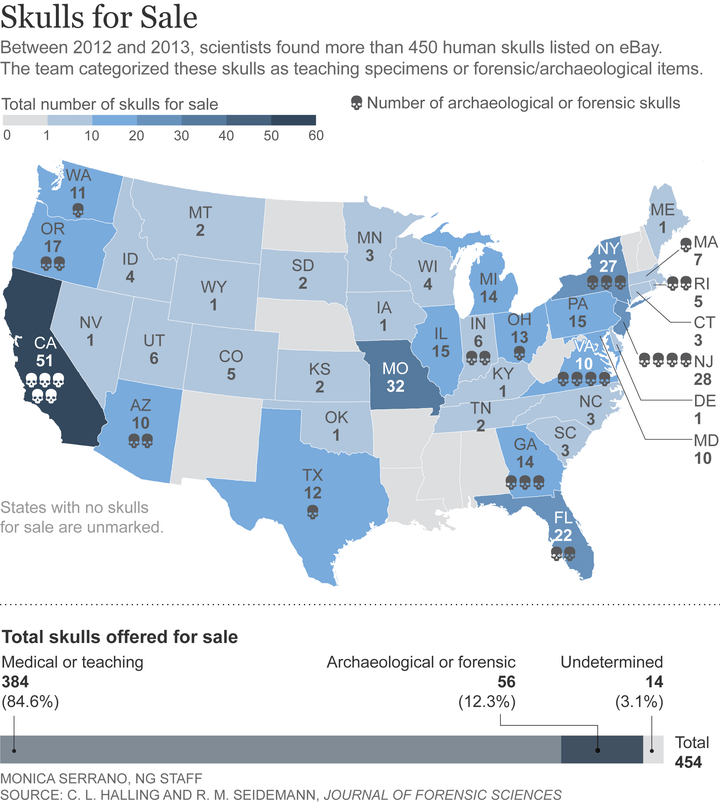
He named his acquisition “Yorick,” the first of many skulls he’d eventually purchase online. By late 2011, he had started carving designs into them and selling them on websites and at conferences, eventually making a living primarily through his boney art.
Wylie was hardly alone: Communities of people who collect oddities and bones were well aware of how easy it was to list something on eBay when no one had to prove provenance or medical affiliation.
But now, academic and legal professionals are starting to take notice.
On July 4, an analysis published in the Journal of Forensic Sciences described how, over the course of just seven months, sellers listed 454 human skulls on eBay, with an average opening bid of around $650. The authors, Christine Halling and Ryan Seidemann with the Louisiana Department of Justice, also noted the trade of human skulls on other websites like Yahoo! and Facebook.
Just four days after the study was published, eBay banned trade in human remains except head hair, which is commonly used to make wigs and Victorian-style art. Sellers’ items were pulled from the site, and any listing fees they had paid were refunded. (Find out more about Victorian-era jewelry made from human hair.)
“The move may signal a drastic rethink of what is currently a largely legal trade in human bones.”
The official reasoning from eBay for the policy change was: “The sale of humans and human remains is prohibited by law, and sellers can’t list them on eBay.”
Perhaps shockingly, that’s not exactly true, but the move may signal a drastic rethink of what is currently a largely legal trade in human bones.
In addition to the eBay decision, the state of Louisiana banned trade and even ownership of almost all human remains shortly after the study appeared. Bone traders started to get nervous. Some deleted their Instagram accounts featuring human remains. Some canceled their interviews with National Geographic. The Bone Room, a store selling bones of all types, sent a note in their August newsletter saying that they consider the eBay ban worrisome.
“I suspect a law will be passed, and I will no longer be able to sell human bones to artists, cadaver dog trainers, or people who just want to own a femur or a skull,” the store owner said in the newsletter.
![360-Degree SkullWylie says: “I was inspired by some of the Tibetan kapalas [ritual skull cups] I saw and wanted to do something similar. I also got done reading the book Deliver Us From Evil, a true story about a police officer who works with exorcists, and I just felt like I needed to make a piece that featured religious relics.”](https://img.huffingtonpost.com/asset/57c07d81180000dd10bcd5c3.gif?ops=scalefit_720_noupscale)
Wylie says: “I was inspired by some of the Tibetan kapalas [ritual skull cups] I saw and wanted to do something similar. I also got done reading the book Deliver Us From Evil, a true story about a police officer who works with exorcists, and I just felt like I needed to make a piece that featured religious relics.”
Historical Heads
Right now, most human skulls in the general U.S. market come from antique medical skeletons.
In the 1700s, medical schools had to provide skeletons for their students, and the supply largely came from India. Hindered by changing laws in 1832 that put an end to unchecked grave robbing in the U.K., British doctors pressured Indian people who dealt with the disposal of human remains to sell the bones instead.
Soon, India had a thriving bone industry that supplied much of the Western world with medical specimens. The history, the opportunity for entrepreneurship, and the fact that many families were too poor to cremate their loved ones helped India dominate the human bone niche.
But in 1985, one dealer was caught selling more than 1,500 child skeletons of unknown origin. India promptly banned exporting human remains over concern that people were being murdered for them. For a while, China took over India’s role as global bone merchant, but they also banned exports in 2008.

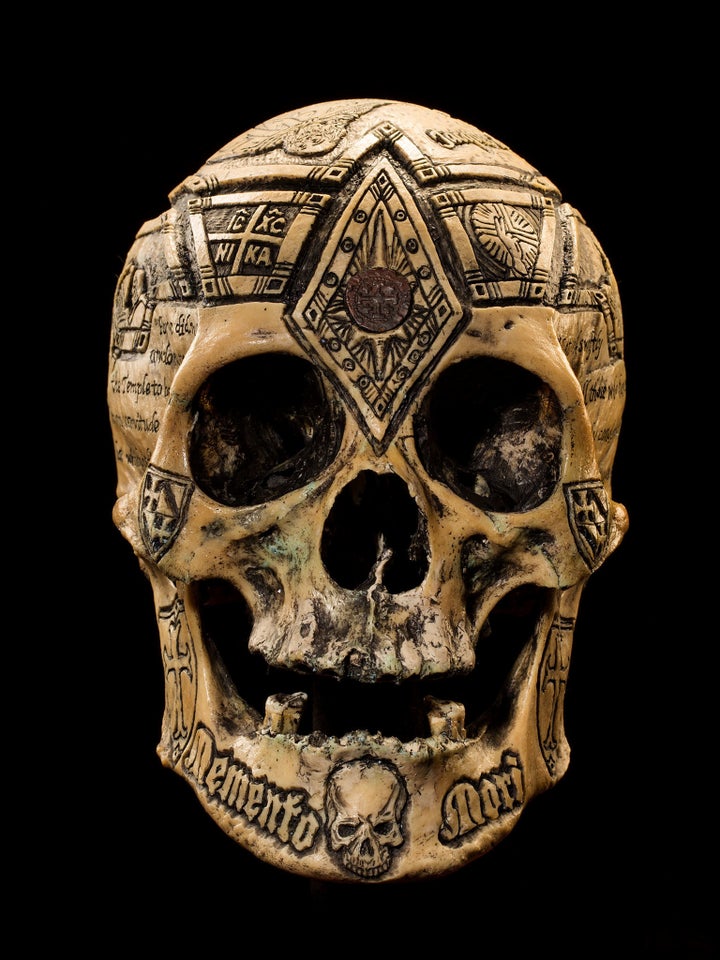
Over time, as various medical schools closed or downsized, or as professors sold off their collections at estate sales, the bones changed hands, and some ended up on the oddities market.
Modern Donors
People in the medical world and related fields can still get new human skulls from U.S. donors. That’s because not all bodies donated for non-transplant anatomical science are studied whole. A doctor might teach her medical students elbow surgery using a dead person’s arm, a chiropractor might want a cleaned spine, and a retailer might take the head for cleaning and sale. (Find out how modern body donation is saving lives.)
Skulls Unlimited is the only company in the U.S. that is legally cleaning human heads that come straight from donors. When they receive a donor head, they cut off as much meat as they can, and remove the brains with a special tool. Then the cleaning crew dries the skulls for a few days before putting them in a colony of dermestid beetles, which will eat off the rest of the fleshy bits.
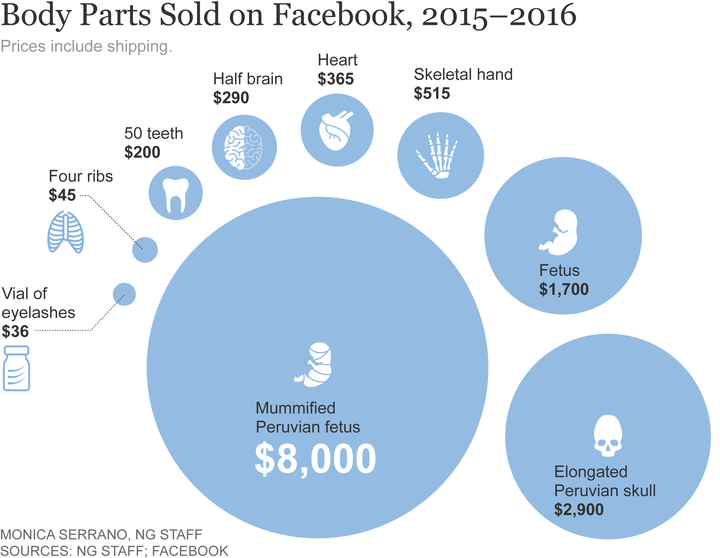
The company will only sell donor skulls to bona fide doctors, nurses, dentists, anthropologists, and people with valid scientific or medical reasons to have them. However, they sell antique skulls to anyone who wants them.
In addition to Skulls Unlimited and The Bone Room, OsteologyWarehouse.com, Skullstore.ca in Canada, and countless brick-and-mortar stores across the U.S. also specialize in selling bones of various species, including humans. You can find human remains for sale on private websites like Wylie’s, plus on some big online platforms like Facebook. (Facebook declined to be interviewed for this article.)
Law and Order
For now, these bone collectors don’t legally need any credentials to buy and sell human skulls that are already on the market. And in the U.S., there is no federal law prohibiting trade and ownership of human remains other than those from Native Americans.
“In 1985, India banned exporting human remains over concern that people were being murdered for them.”
Many collectors erroneously believe that only three states—New York, Georgia, and Tennessee—ban trade in human remains across state lines, based on a post on The Bone Room’s website and reiterated in their August newsletter.
In reality, the laws are lacking in some states, unenforced in others, and nearly impossible to fully comprehend by buyers, sellers, or site administrators.
Seidemann, who is an attorney at the Louisiana Department of Justice, agrees that the laws are too protean and complicated for sellers to keep track of. “It’s a moving target,” he says. There is no comprehensive online resource to determine the legality of trade in human remains on a state-by-state basis, and neither academics nor collectors (even the ones with lawyers) were able to cite the details of each state’s laws when asked by National Geographic.
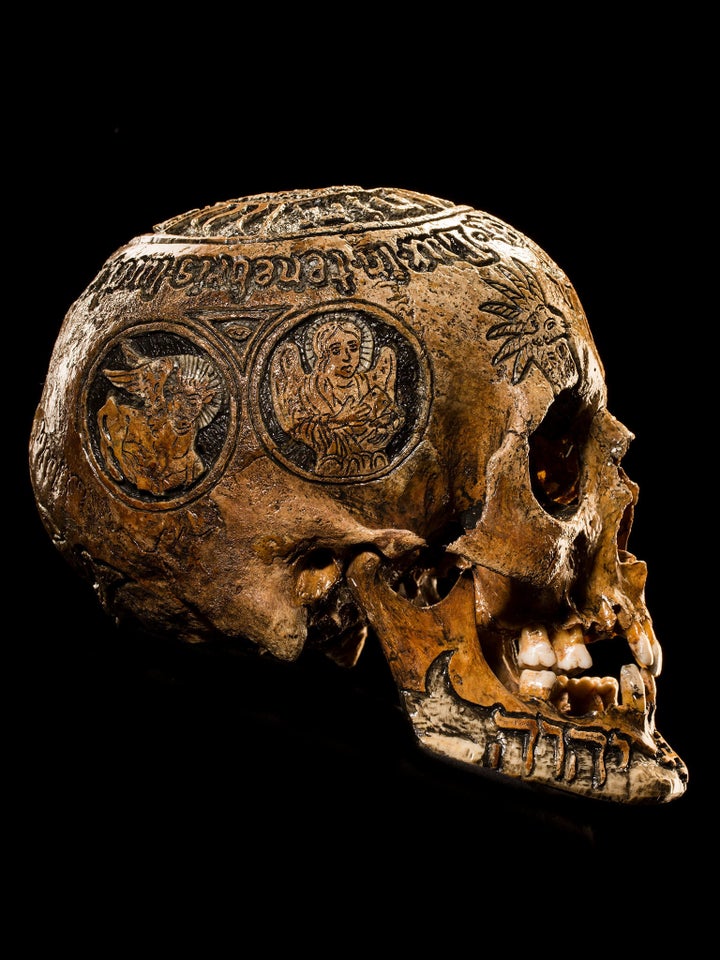
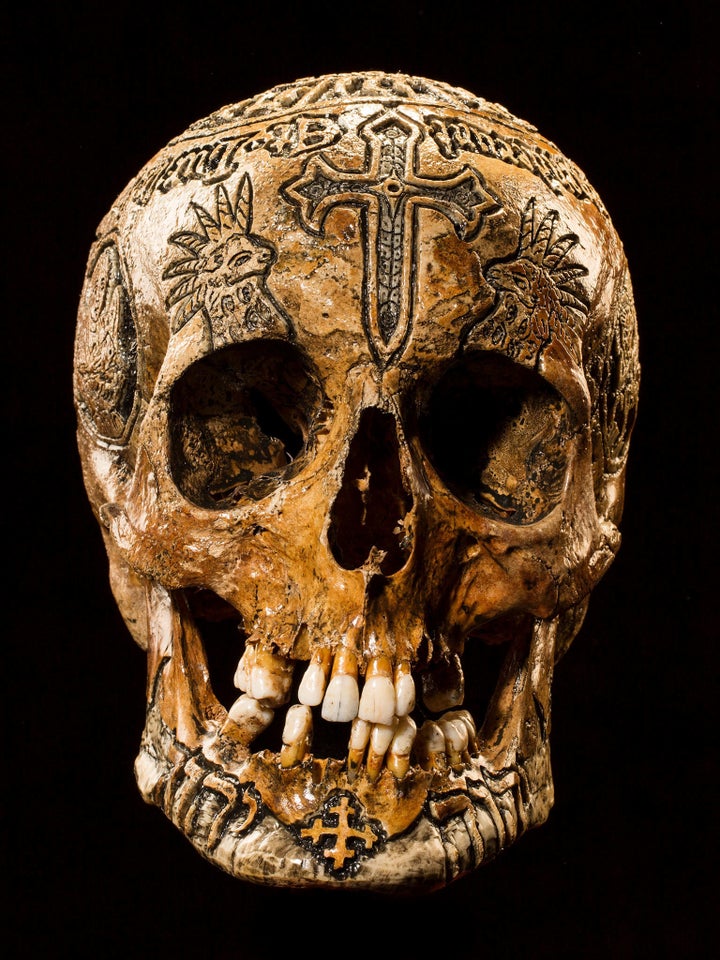
However, even if human bones are technically legal to own and trade, there is a chance that some remains were grave-robbed, stolen, or misappropriated. The recent article by Halling and Seidemann noted that 56 of the 454 skulls they analyzed from eBay were probably not medical specimens, but ones of forensic or archaeological interest.
Brian Spatola, curator of the anatomical division of the National Museum of Health and Medicine in Maryland, says that he has recovered several human skulls that had gone missing from academic collections just by watching eBay.
“In many of these instances, the materials were being sold by someone who claimed to have purchased them from an estate sale and professed to not know its history,” Spatola wrote in an e-mail statement on the topic. “Each of these was ultimately returned.”
Shroud of Secrecy
Ethical concerns are no less complicated. Damien Huffer, an anthropologist at the Smithsonian’s Museum Conservation Institute, would like to see collectors stop trading in human remains, especially archaeological and ethnographic specimens, on social media. Ownership is “legal by default,” he says, “but that doesn’t wave away all the issues.”

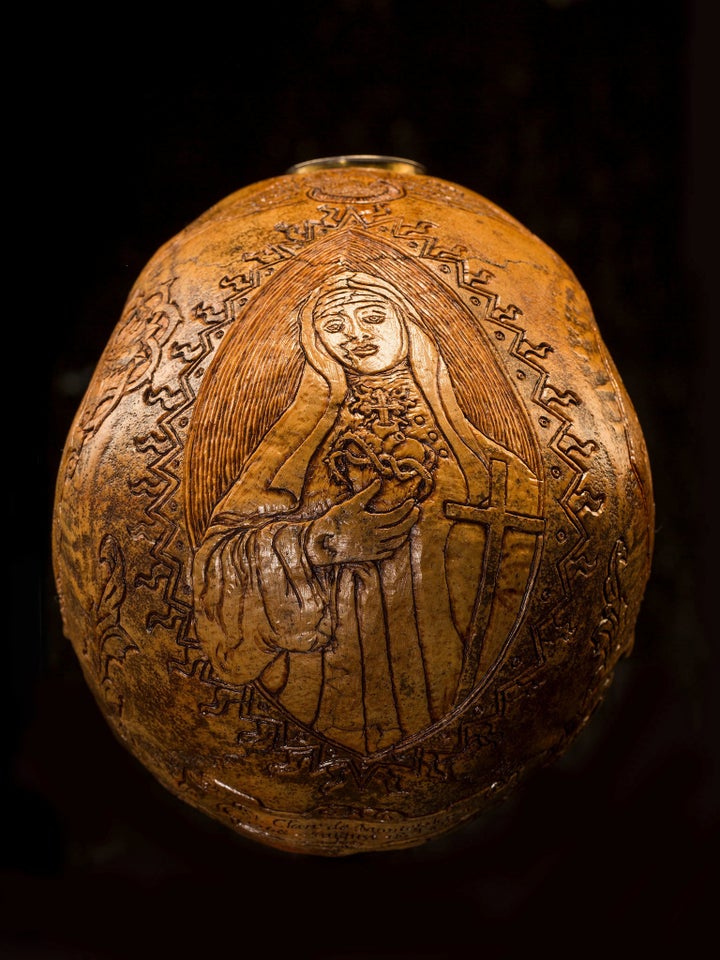
Huffer and his colleagues monitor website tags used by human remains traders on Instagram and other social media sites. He suggests that other users do the same and report people who sell remains to Facebook and Instagram. That way the companies are aware it is happening, even though right now neither of those websites has anything in their terms of service or community standards that restrict such sales.
Still, collectors usually have their own code of ethics, and most know what to avoid.
Skulls Unlimited co-owner Josh Villemarette is confident that the skulls they trade in come only from legitimate sources: “If it was a murder victim, there would definitely be ways for us to know that, just because the standard person’s not going to be able to get it clean,” says Villemarette, adding that he has never been offered something that he even suspects came directly from a murder victim.
“But there are times when you receive a photograph of a skull that someone’s wanting to sell that’s very clear that it’s been dug up,” he says.
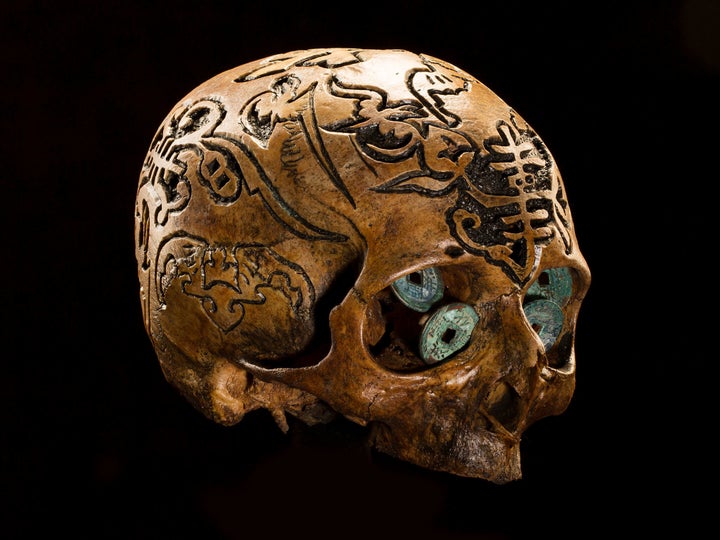
“Something that’s intended for medical purpose, cleaned and sold into the scientific field, and refurbished ones—those are very clear that they’ve been intentionally cleaned for that purpose. Anything that’s been cleaned underground, there’s a very distinct look to them. That’s a red flag to us, and when we get those photographs, we straight away tell them that we’re not interested.”
And despite the recent dustup over eBay and Louisiana, Wylie says he’s not too concerned about his business. He figures that more people will instead buy directly from his website or from sellers at conventions, adding that anyone who wants to become art after they die can will their skull to him. (Read about other creative things to do with a dead body.)
So at least for now, he and other bone traders continue to sell online, just with a little more secrecy and care than they had before.
“Somebody who buys skulls and somebody who sells skulls, we don’t like to trade names,” says Wylie. “All it takes is for somebody to write an article, and our business could be over.”
Follow Kristin Hugo on Tumblr.
More from National Geographic:
In Search of the Lost Empire of the Maya
